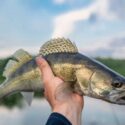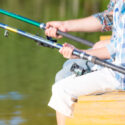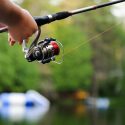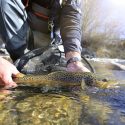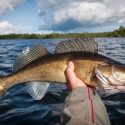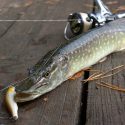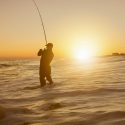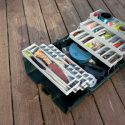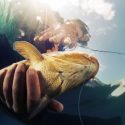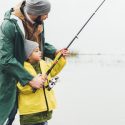Walleye fishing is a worthwhile pursuit that brings joy to anglers across North America each year. These sought-after fish are known for their elusive behavior, sharp eyesight, and delicious flavor, making them one of the most popular freshwater fish to target.
It doesn’t matter if you’re a seasoned angler or a beginner, mastering the art of walleye fishing requires an understanding of their behavior, the right gear, and effective techniques. In this comprehensive guide, we’ll provide you with the essential tips, tactics, and knowledge needed to increase your success on the water.
Walleye tend to be more active in cooler temperatures, particularly during the spring and fall months – the prime times for walleye fishing. Understanding their preferences – for certain depths, structures, and times of day – can seriously improve your catch rate. In the following guide, we’ll explore the key elements that contribute to successful walleye fishing, ensuring that you’re prepared for your next outing:
Understanding Walleye Behavior
The most important aspect of walleye fishing is understanding the behavior of the fish and how it changes through the years. They’re primarily nocturnal, meaning they are most active during low-light conditions such as dawn, dusk, and overcast days. During the daylight, they tend to retreat deeper into the water where they tend to feel more secure. In regions where water clarity can vary, walleye may remain active in shallower waters even during the day, especially if the water is stained or murky.
Walleye are structure-oriented fish, meaning they prefer to stay close to features as points, drop-offs, submerged humps, weed beds, and rock piles. These structures serve the dual purpose of providing cover and allowing for an ambush point for hunting prey. Around the beginning of spring, they’ll begin to move into shallower waters to spawn, often congregating around rocky shorelines, river mouths, and sandy flats. When summer hits, they tend to move deeper, seeking out cooler water and following schools of baitfish. As temperatures begin to drop near the start of fall, walleye return to the shadow to feed more heavily in preparation for the long winter ahead.
If you want to successfully fish for walleye, it’s crucial to understand these seasonal movements and behavioral patterns. By knowing where walleye are likely to be at any given time, you can more effectively target them and increase your odds of a successful outing.
Essential Gear for Walleye Fishing
When it comes to fishing for walleye, having the right gear is half the battle. While they aren’t the strongest fighters among freshwater species, they do require a finesse approach due to their cautious nature. You’re going to want a medium-light to medium-power rod paired with a high-quality spinning reel. Look for a rod that has a more sensitive tip, as walleye buts can sometimes be subtle depending on their mood.
When it comes to line, monofilament, fluorocarbon, and braided lines all have their place in walleye fishing. Monofilament tends to be more forgiving and works well for live bait presentations, while fluorocarbon offers low visibility, making it ideal for clear water and finicky fish. Braided line works well for jigging and trolling due to its strength and sensitivity, but it’s best paired with a fluorocarbon leader to reduce visibility.
Meanwhile, live bait is often the go-to choice for walleye anglers, especially in the spring and fall. Minnows, leeches, and nightcrawlers are all highly effective examples. Artificial lures also play a crucial role here, with jigs, crankbaits, and soft plastics being the most popular options. Jigging tends to be a particularly effective method as it allows you to present you bait near the bottom, where walleye often feed. Crankbaits can be great for covering large areas while trolling, while soft plastics offer versatility.
Techniques for Successful Walleye Fishing
If you want to be consistently successful when fishing for walleye, it’s vital to master a variety of techniques. Each technique will have its own strengths, suited to different conditions, so it’s important to know when and how to apply them.
- Jigging: Jigging is one of the most versatile and effective techniques for walleye fishing. No matter if you’re fishing in deep water or along shallow weed lines, jigging allows you to present your bait precisely where the fish are. Vertical jigging is particularly effective in deeper waters, while casting and retrieving jigs work well in shallower areas. Use soft plastics, live bait, or a combination of both on your jig for the best results.
- Trolling: Trolling is a great way to cover large areas of water and locate active fish. Use crankbaits, spinner rigs, or bottom bouncers to maintain the right depth while you move through different zones. Pay attention to your speed and the action of your lure, as walleye can be picky about both. Trolling is especially effective and important in summer when walleye are spread out and suspended in deeper water.
- Casting: Casting is a technique used to target specific structures like weed edges, rock piles, or drop-offs. Use crankbaits, jerkbaits, or spinners to cover these areas effectively. You’ll want to adjust your retrieval speed based on water temperature and the activity level of the fish. In colder water, a slower retrieve is often more effective, while a faster retrieve works better in the heat.
- Drift Fishing: Drift fishing is a natural way to present your bait in areas with current or wind. This technique works best in rivers and large lakes, allowing you to cover ground while keeping your bait in the area you want it. Use a slip bobber or bottom rig with live bait to target walleye that are holding near the bottom, likely in warmer months.
Tips for Specific Walleye Fishing Conditions
Walleye fishing conditions can vary greatly, depending on the time of year, the weather, and water clarity. Adapting your tactics to these conditions is crucial for success. Here’s how to adjust your approach based on the varying seasons:
- Spring: Spring is one of the best times to fish for walleye, especially in places like Northwestern Ontario. When the water warms, walleye move into shallow areas to spawn. You should target rocky shorelines, river mouths, and shallow flats where walleye are likely to congregate. Around this time, you should use jigs tipped with minnows or soft plastics to entice more bites. A slow and steady presentation is often most effective.
- Summer: When walleye start to swim deeper in the summer, trolling becomes particularly effective. Use crankbaits or spinner rigs to cover water and find schools of fish. Focus on structure like deep points, humps, and submerged weed beds. Early morning and evening tend to be the best times to fish, as walleye will move into shallower water during these low-light periods.
- Fall: Fall is an excellent time for walleye fishing, especially in Northwestern Ontario. As the water cools, walleye become more active and move back into shallower areas to feed before winter. This is the time to use jigs, crankbaits, and soft plastics. Focus on areas with access to deep water, such as drop-offs and points, as walleye will move between shallow and deep water depending on the time of day.
- Winter: Ice fishing for walleye requires a different approach. Walleye become less active during the winter because their metabolism slows down. Use small jigs tipped with live bait and, like summer, focus on areas with structure. Pay attention to subtle bites, as walleye are often more finicky during the winter months.
Common Mistakes to Avoid
Even the most experienced angler can make a mistake when fishing for walleye. Here are some common pitfalls and how to avoid them:
Overfishing a Spot
Walleye can be highly mobile, especially when they’re not actively feeding. If you’re not getting bites, consider moving to a different location of trying a different depth.
Ignoring Seasonal Patterns
As we covered above, walleye behavior changes with the seasons, so it’s important to adjust your tactics all year round. For example, fishing shallow in the spring and fall and deeper in the summer can make a significant difference.
Incorrect Lure Presentation
Walleye tend to be finicky, so presenting your lure naturally is crucial. You’ll want to avoid overly aggressive movements and focus on matching the speed and action of the local forage.
Not Paying Attention to Weather Conditions
Weather can have a real impact on how walleye act. Windy, rainy, and overcast days are often more productive than bright, sunny days. Adjust your tactics to match the conditions – fish deeper on sunny days and shallower on cloudy ones.
Conservation and Ethical Fishing Practices
Conservation and ethical fishing practices are essential to ensuring that walleye populations remain healthy for future generations. Practicing catch and release is particularly important for large breeding females, since they play a crucial role in sustaining the population. When handling walleye, make sure your hands are wet or else use a rubber net to avoid damage their protective slime layer. If you plan to release the fish, try to do so quickly and gently.
It’s also vitally important to respect local fishing regulations. In Northwestern Ontario, size and bag limits are in place to protect the walleye population. Always check the current regulations before heading out on the water and adhere to them strictly.
By practicing ethical fishing and conservation, you contribute to the long-term sustainability of walleye fisheries, ensuring that future generations can enjoy this incredible sport.
Walleye Fishing at Mattice Lake Outfitters
Walleye fishing is both challenging and rewarding. It requires a combination of knowledge, skill, and adaptability. When you strive to understand walleye behavior, use the right gear, and master effective techniques, you give yourself significantly better odds at success on the water. The key to mastering walleye fishing is to stay curious and adaptable. Conditions can change rapidly, and being able to adjust your approach on the fly is essential.
If you’re looking to put your knowledge, skills, and experience to the test, Mattice Lake Outfitters offers some of the best walleye fishing in Canada, along with beautiful scenery and comfortable accommodations. Call us toll free at 1-800-411-0334 or email us at mattice@walleye.ca to learn more!
